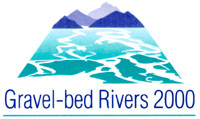Introduction Study area Method: Photogrammetry Method: Water depth estimation Final riverbed surface Conclusions References Links & Acknowledgements

|
Introduction Study area Method: Photogrammetry Method: Water depth estimation Final riverbed surface Conclusions References Links & Acknowledgements |
 |
1: Introduction
Traditionally, gravel-bed rivers have been managed using monitoring programmes based on cross-section surveys. The location and spacing of the cross-sections and the frequency of re-survey are usually determined, at least in part, by considerations such as financial cost and ease of access, rather than geomorphological factors such as the typical spatial and temporal scales of topographic change. This will inevitably mean that changes in riverbed topography that occur at smaller space and time scales are not detected, regardless of their importance in determining channel processes and change. However, the time and resources needed to survey large braided riverbeds at 'morphologically-appropriate' spatial and temporal scales commonly makes manual survey techniques prohibitive.
An attractive alternative to manual survey is digital photogrammetry, a 'remote survey' tool increasingly used in Earth Sciences. With appropriate stereo-aerial photographs, camera calibration information and ground control targets, digital photogrammetry can be used to obtain high-density, high-accuracy topographic representation in the form of digital elevation models (DEMs) (Lane et al., 1994). Successful application of photogrammetry in geological and civil engineering applications has provoked interest from geomorphologists, and recent advances in photogrammetric software have meant the automated, 'digital' photogrammetry is now available to a wide range of users. However, despite the increased accessibility and reduced cost of digital photogrammetry, there have been relatively few applications in fluvial geomorphology, in part due to uncertainty in areas inundated with water. Large, braided riverbeds pose another difficulty in that they typically contain very small vertical relief (in the order of metres) in relation to their spatial extent (often hundreds or thousands of metres width). The implications of this for digital photogrammetric survey are also unknown.
Previous work has shown how digital photogrammetry can be successfully used to extract 'total' coverage of the riverbed of the North Ashburton River, New Zealand, a shallow, clear-water gravel-bed river (Westaway et al., 2000; Westaway et al., submitted). This study focuses on the much larger Waimakariri River, New Zealand, which has more turbid water, meaning that the submerged bed can not be seen in most inundated areas. In these zones, photogrammetry cannot be used and, instead, image analysis will be used to derive an empirical relationship between water colour and water depth. This will subsequently be combined with photogrammetric survey of exposed areas to give 'total' riverbed topography.
Hence, the research aims are as follows:
Keywords: digital photogrammetry; image analysis; DEM; riverbed morphology
Introduction Study area Method: Photogrammetry Method: Water depth estimation Final riverbed surface Conclusions References Links & Acknowledgements